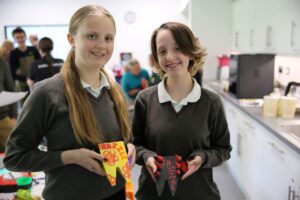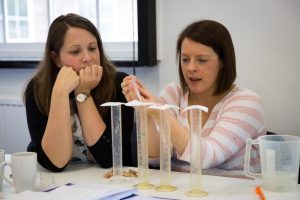Signs of Spring at Stansfeld Park
Friday 4th May 2018
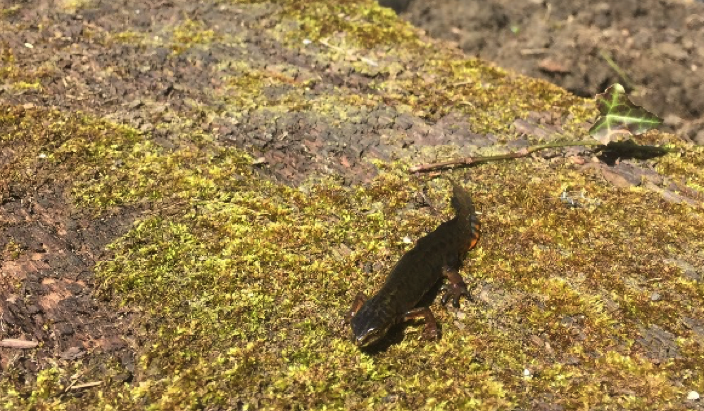
From newts to badger cubs and bluebells, signs of a new season are springing up across the fifteen acres of woodland at Stansfeld Park, home to our new science and innovation centres development. Roger Baker, our resident Outdoor and Ecology Manager, reports.
“Well, what a soggy start to the year! After a cold winter, accompanied by several falls of snow and temperatures as low as -11⁰C, we have been faced with a prolonged chilly and wet start to spring.
However, the signs of change can now be seen all around our stunning woodland, even as the construction of the new centres continues apace nearby. (Watch the build in real time on webcam).
As all gardeners will know, a lot of preparatory work needs to be done in the dormant season and we’re starting to see the fruits of our labour, alongside other wonders that we can claim less credit for.
Thanks to Oxford Conservation Volunteers (OCV) and enthusiastic helpers from the local area, some heavy-duty work has been carried out on our ponds to remove several decades of gloopy, and at times stinky, sediment. We have also restored and deepened the areas of open water and can see already the positive impact this is having, with the aquatic vegetation, waterfowl, invertebrates and amphibians returning. Now that the ponds are rehabilitating, we’re turning our attention to the terrestrial habitats around the park.
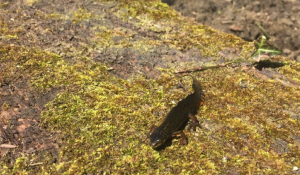
A common newt (Lissotriton vulgaris) returning to one of our restored ponds.
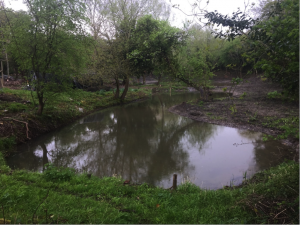
One advantage of the wet start to the year is that our ponds are now brim full!
While the shoots and buds have been slightly delayed this year, the recent spells of sunshine have brought about some rapid green emergence. Last November, local families helped us to plant several hundred bluebell (Hyacinthoides non-scripta) bulbs and telltale shoots in February brought much excitement. Unfortunately, even more excited than me were the local muntjac deer (Muntiacus reevesi) who promptly munched the lot! One hastily installed deer fence and – nearly three months later – we’re just about to see a modest carpet of blue.
Another early emerger is garlic mustard (Alliaria petiolata), which is found throughout the woods. This plant is actually good for us to eat, tasting (as its name suggests) subtly of spicy garlic. It doesn’t have the same gastronomic appeal to the deer as bluebell bulbs do but provides a good foodplant for the larvae of the beautiful orange tip butterfly (Anthocharis cardamines). The adult butterflies lay vivid orange eggs on the plant so the caterpillars can gorge themselves as they grow.
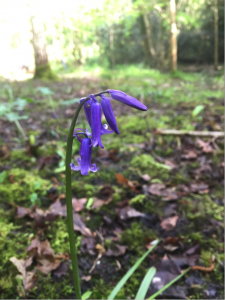
One of our first flowering bluebells (Hyacinthoides non-scripta) from the bulbs planted by volunteers last year.
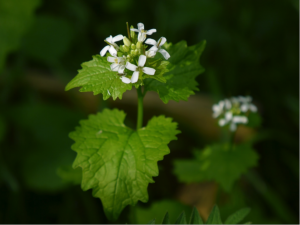
Known by many names including garlic mustard and jack-by-the-hedge, Alliaria petiolata is another early species that flowers before the developing tree canopy shades them out.
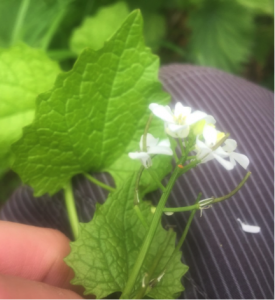
The distinctive orange egg of the Orange Tip butterfly (Anthocharis cardamines) on garlic mustard.
The invertebrate population has largely been lying dormant throughout the recent months but minibeasts are already becoming more evident as I move between the decaying wood piles and developing undergrowth.
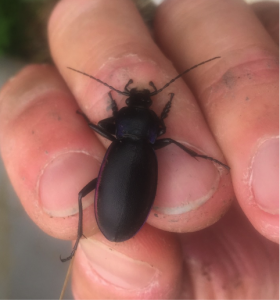
Violet ground beetle (Carabus violaceus), a ‘minibeast’ capable of giving a good nip (as here!)
At this time of year I am very careful not to disturb the nesting birds, particularly in one clearing where I had installed two carefully constructed (by my own children) bird boxes in January. Knowing that the chance of occupancy in the first year was reasonably slim, I was amazed and overjoyed last month to see both boxes being used. We’ll be putting up more this year to help boost the bird population across the site, so those orange tip butterflies will need to watch out.
As a result of our bird surveys last year, many of the birds in the woods have been individually tagged. Have a look here to find out how you might be able to help us track their movements on a community ‘Robin Watch’ project.
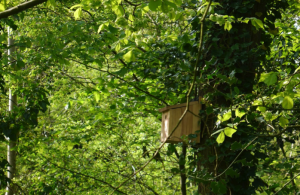
A newly installed nest box that has already seen some action.
One of the real highlights of the year so far for me was some really special footage we captured on one of our infra-red tracking cameras, which monitor the wildlife across the site.
Due to the increase in activity in one corner of the woods, I re-positioned the cameras hoping to catch a glimpse of some new animal residents. Finally, on 17th April, I saw what I had been hoping for; not one, two, or even three, but FOUR healthy looking badger cubs (Meles meles) out investigating with a parent. These fascinating but elusive animals usually give birth in February, but their young rarely appear above ground until they’re at least eight weeks old. Interestingly, the adults breed throughout the year but delay implantation until December. This is believed to make the most of any period that males and females are together, but ensures that the young are always born in spring and can take advantage of increased food resources at that time of year.
Like me, our resident badgers are now throwing off the shackles of winter and enjoying the vibrant, abundant wildlife that comes in spring.
A first glimpse of an adult badger (Meles meles) showing three of their four cubs (one out of shot) how to forage for themselves.
You can find out more about Roger Baker in our staff profiles.
Click on his picture and scroll down.


